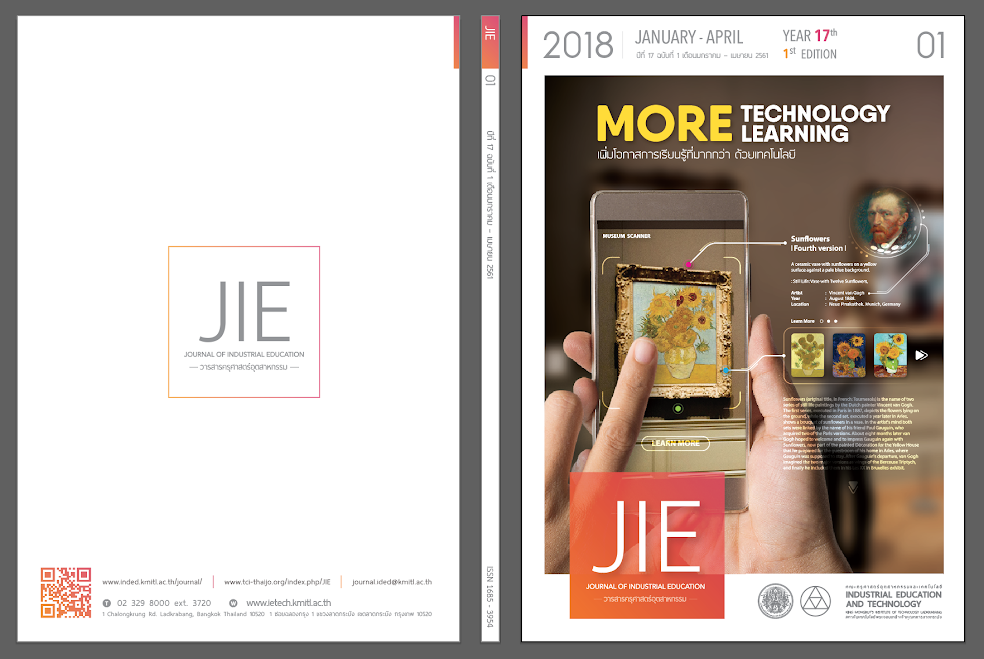THE DEVELOPMENT OF MULTIMEDIA COURSEWARE ON EARTH AND SPACE IN GRADE 4
Keywords:
Development, Multimedia Courseware, Quality Evaluation, Efficiency, Posttest AchievementAbstract
The objectives of this research were 1) to develop the multimedia courseware on Earth and Space in Grade 4 for the quality and the efficiency, and 2) to compare the learning achievement on Earth and Space in Grade 4 of the pretest and the posttest after learning with the courseware on Earth and Space. The samples consisted of 31 Grade 4 students from Ao Chang Lai School, Chachoengsao Province during Academic Year 2017 via simple random sampling. The research tools included multimedia courseware on Earth and Space in Grade 4, an evaluation form for the quality of the multimedia courseware, and a learning achievement test containing 20 items. The index of item–objective congruence (IOC) was 0.67–1.00. The item difficulty index (p) ranged from 0.41–0.71. The discrimination (r) ranged from 0.24–0.53 and the reliability (rtt) was 0.85. The statistics used in the analysis were the mean ( ), standard deviation (S), Process Efficiency (E1)/ Product Efficiency (E2) and t-test for dependent samples.
The research results revealed that
1) The multimedia courseware on Earth and Space in Grade 4 had a good overall quality ( = 4.43, S = 0.54); when considering each aspect, the content quality was at a good level (
= 4.22, S = 0.64); and the quality of media production technique was at a very good level (
= 4.65, S = 0.45).
2) The multimedia courseware on Earth and Space in Grade 4 had efficiency E1/E2 equal to 81.13/86.29 as the defined criterion.
3) The posttest achievement of the students after learning with the multimedia courseware on Earth and Space in Grade 4 was higher than that of the pretest with statistical significance at the .05 level.
References
[2] Ministry of Education. 2008. The Basic Education Core Curriculum Science. Bangkok: Ministry of Education.
[3] Michael Molenda. 2003. In Search of the Elusive ADDIE Model. Retrieved March 1, 2017, from https://yuripavlov.ru/wp-content/uploads/2017/07/MolendaProtsessADDIE.pdf
[4] Pairod Treeranatanagul, et al. 2003. Design and Production of Computer-Based Instruction For E-Learning. Bangkok: Bangkok Media Center.
[5] Chaiyong Pomwong. 2013. Developmental testing of media and instructional package. Silpakorn Educational Research Journal, 5(1), p. 7-19.
[6] Anderson and Krathwohl. 2001. Taxonomy for learning, teaching and assessing: A Revision of Bloom’s Taxonomy of Educational Objectives. New York: Longman.
[7] Punnee Leekitchwatana. 2015. Educational Research Methodology. 11th ed. Bangkok: Mean Service Supply.
[8] Mayura Uma. 2012. The development of computer multimedia Instruction on Global Warming for Grade 4 Students. Master of Education, Faculty of Education, Srinakharinwirot University.
[9] Sawitya Yotrabam. 2014. The Development of Computer Multimedia Instruction in Science Substance on Universe and Space for Grade 6. Educational Technology and Media Communications Journal, 1(1), p. 109-116.
[10] Patcharaphan Hiruncharoenvet. 2015. Multimedia Instruction via Tablet on Light Energy. Master of Industrial Education, Industrial Education and Technology, King Mongkut's Institute of Technology Ladkrabang.
[11] Natima Pattanamad. 2015. The Development of Computer-Assisted Instruction on Plant and Animal of Primary students. Master of Science, Industrial Education and Technology, King Mongkut's Institute of Technology Ladkrabang.
[12] Charnnarong Phuangphaka. 2013. The development of Computer Assisted Instruction on The Rocks and The Earth Changing for prathomsuksa 6. Veridian E-Journal, 6(2), p. 102-112.
[13] Supara Sangkaew. 2011. Development of Computer Assisted Instruction (CAI) Lessons Entitled Earth and Space Science the Science Learning Substance for 6th Grade Education. RMU.J, 5(1),p. 39-48.
Downloads
Published
How to Cite
Issue
Section
License
"The opinions and contents including the words in papers are responsibility by the authors."
"ข้อคิดเห็น เนื้อหา รวมทั้งการใช้ภาษาในบทความถือเป็นความรับผิดชอบของผู้เขียน"



